Surfboard Shaping Tools of the Trade
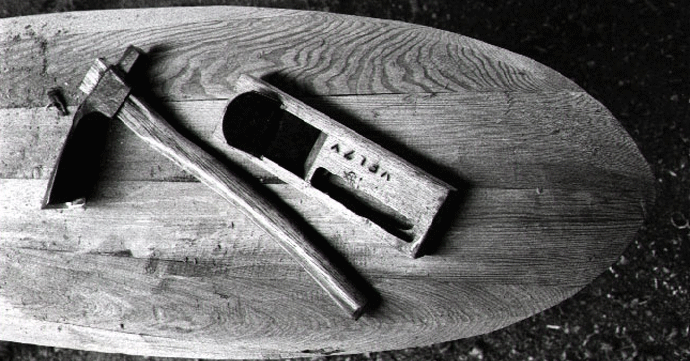
A look into the tools our master shapers require to sculpt you that magic stick
We have had a few articles in the past talking about what goes into building a surfboard. Design principles like looking at different
surfboard outlines, the different
glassing options and even the differences between standard
Poly and Epoxy Surfboards. But one thing we have not covered is simply the tools that these master shapers use to make your magic whips.
Now just to be clear, there is not one standard tool set that shapers use. For the most part, surfboards are made up of a soft medium, being the foam (whether EPS or Poly), and then a harder medium made usually out of wood, which would be the stringer. So technically, you can shape a complete board out of sand paper alone, but that would be very time consuming. Most of the tools do however come from the woodworking industry.
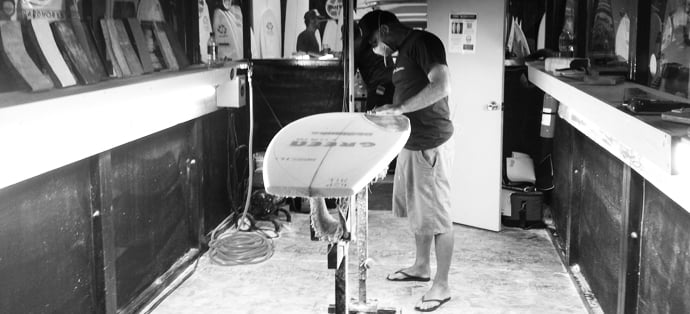 Gary McNeill of Gary McNeill Concepts keeps a clean room and organized shaping pads on one side, block planes on the other.
Gary McNeill of Gary McNeill Concepts keeps a clean room and organized shaping pads on one side, block planes on the other.
No matter what tools have been chosen for the job though, shapers, whether they are using self made equipment or buying tools designed specifically for shaping, covet their tools like they are sacred artifacts and will rarely let another soul touch them. In-fact, you should see the amount of tools shapers acquire over time. Many of them have multiple electric planers, surforms, block planes, etc...they just can’t bring themselves to let their magic tools go.
So you might be asking yourself, what are the basic tools that most shapers have in the quiver?
As mentioned above, you can get away shaping a surfboard with some basic tools available at your local hardware store. But that would take an unnecessarily long time, so there are some key tools that most shapers have, that you could get your hands on pretty easily if you wanted to have a stab at shaping a board yourself.
A basic breakdown of a decent set of tools most shapers have would look like this:
- Electric Planer
- A Block Plane and a series of other bladed tools including the David Plane, Trim Plane and a Spoke Shave
- Surform and curved rasp
- Various grits of Sand Paper and sanding pads/blocks
- Various grits of sanding screen and finish pads
- Calipers and Shapers Square
- Dust Masks
The Electric Planer
The electric planer, usually the most coveted of these tools plays such an important role in the process of shaping a board. This planer will plow through both the foam and the stingers with ease and accuracy. A master shaper can rough out a board to an almost finished state with this tool alone. It’ll take your board down to the thickness you need, turn the rails to the basic shape you are looking for and can even rough out concave and other bottom contours needed for your board. You can get the job done without it, but it takes hours off the labor needed when using more basic tools like block planes and abrasives. Even for the average or beginner shaper, the electric planer is useful for the daunting task of getting your board to the thickness required before they start to tackle concave, foils, etc.
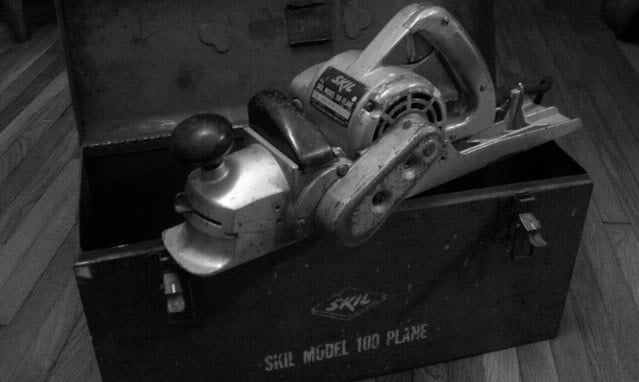 The highly coveted Skil 100 Planer, a shapers dream tool!
The highly coveted Skil 100 Planer, a shapers dream tool!
The Block Plane and Other Bladed Tools
Block planes, trim planes and spoke shaves are essential for working the stringer of a board. The stringer is usually made up of a wood of some sort. Being surrounded by a much softer medium, the foam, it is difficult to get a clean finish of the two side by side. The use of a good, sharp block plane is great for refining the stringer down to the same level as the foam, or even slightly lower with the proper technique, without tearing up the foam around the stringer too much. It is surprisingly difficult to achieve and is a good mark of an expert craftsman. The David Plane, trim plane and spoke shave are more or less various sizes/takes on the block plane and are used to working the stinger in complicated areas and curves that the block plane simply cannot fit. Again, a clean finish of foam next to the stringer is a sign of an experienced shaper, very sharp tools and excellent technique.
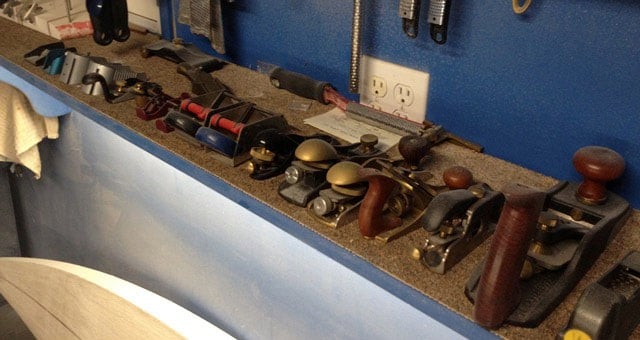 A beautiful quiver of block planes.
A beautiful quiver of block planes.
The Surform and Curved Rasp
A surform is kind of a cross between and abrasive (like sandpaper or sanding screen) and a planer. The blade of a surfer resembles that of a cheese grater. This a handy tool as it can be used to take down and level out ridges left over from using your electric planer. It’ll cut through both the foam and the stringer with ease. If you are starting out and can’t afford or get use of an electric planer, be sure to get yourself a surform as it is probably the next best thing to tackle the tedious tasks such as taking down thickness, starting contours, etc. The curved rasp is essentially a curved version of the surform and is extremely useful for swallow tailed boards, etc where you still need to get the stringer down in-between the crack of the swallow tail.
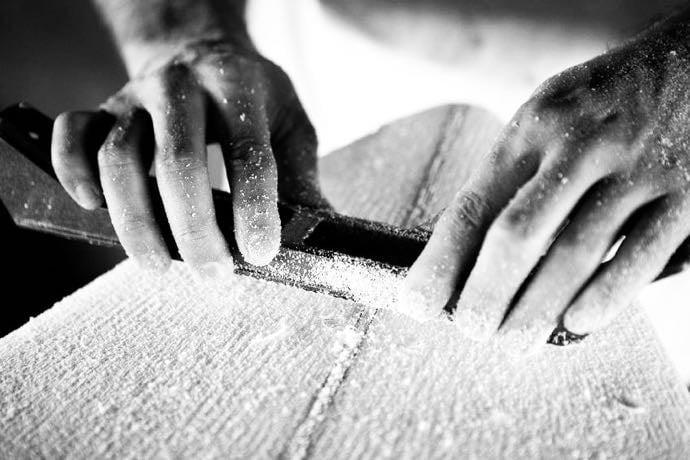 The surform is great for many applications, a must have for any shaper.
The surform is great for many applications, a must have for any shaper.
Sandpaper and Sanding Blocks/Pads
Now we start getting into abrasives. Using various grits of sand paper and a sanding block or pad allows you to perform similar tasks to the surform, yet working into a finer finish the higher the grit you go. The sanding block/pads can be made up of anything from wood to soft foam. Harder wood blocks that you wrap your sandpaper around will be for truing up the lines and ridges left by other tools, whereas the softer pads are usually used with the high grit papers for a finer finish and to fit the various curves and contours throughout the board.
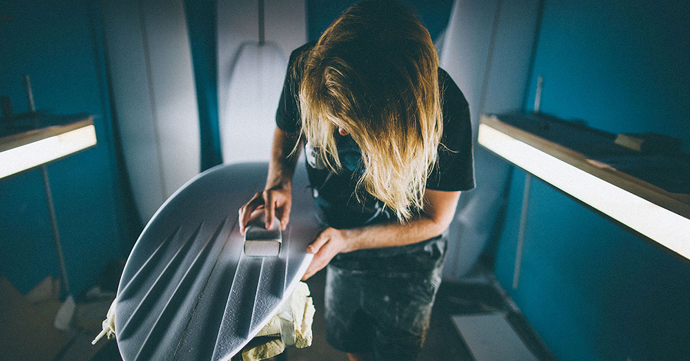 Max Stewart making good use of his sanding blocks on the channels of this Eye Symmetry Custom.
Max Stewart making good use of his sanding blocks on the channels of this Eye Symmetry Custom.
Sanding Screens and Finishing Pads
Sanding Screens are the next tool up from your sandpapers that helps clean up your shape. A good range of grit used here would be an 80 grit, 120 grit and 220 grit screens. You can use these on their own wrapping them around the rails helping to take out and clean up the lines and ridges left by your planers and surforms that got used to rough out the shape of your rails. If you have bigger ridges or steps in the rail, you can go with the lower grit like the 80 and then work your way up to the 220. This requires a delicate touch and a keen eye to ensure that your rails match on each side of the board. These screens are used with a soft foam finishing pad across the deck and bottom, it's used to get an ultra clean finish.
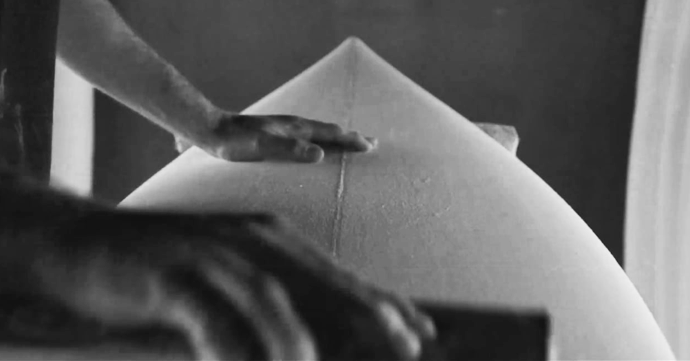 Panda Surfboards shaper Blake Peters working his way to a clean finish.
Panda Surfboards shaper Blake Peters working his way to a clean finish.
Calipers and Shaper Squares
Calipers and shaper squares are simply measurement tools used to get the exact measurements before a shaper tackles the blank, they also ensure measurements are correct during and after shaping. The calipers measure the thickness in any give area of the board, whereas the shaper square has multiple applications. Not only can it measure the width at any given area, it can also be used to help you plan and mark fin placement, channels, or anything that you need exact measurements from one side of the stinger to the other.
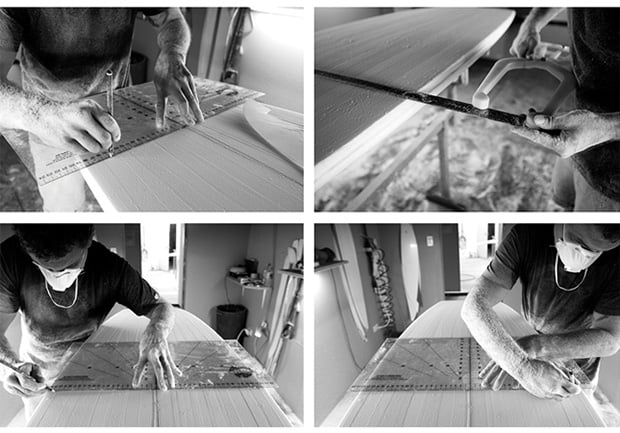 Calipers and Shaper Squares get plenty of use at DMS Surfboards.
Calipers and Shaper Squares get plenty of use at DMS Surfboards.
The Dust Mask
Last but not least, intact one of the most important tool a shaper needs is a good dust or particle mask. Both Polyurethane and EPS blanks can be very hazardous to your health with prolonged exposure and inhalation. Foam is known to cause forms of cancer and other health issues, so using a good dust mask is vital to a long shaping career let alone a long healthy life. Always be prepared!
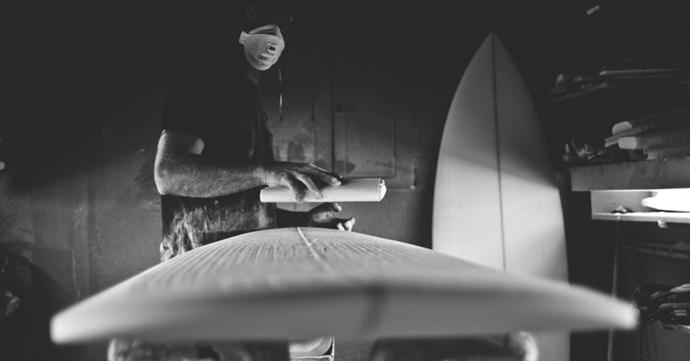 A good dust mask is essential for a long and happy shaping career.
A good dust mask is essential for a long and happy shaping career.
Summary
There are so many other tools that we haven’t even touched on and to be honest, there are no rules or regulations on what can be used to shape a surfboard. It is an art form after all, and many shapers will create their own tools as they see fit to help them get the job done. The tools that we have outlined here are not intended to tell you what you NEED to shape a board, but they are commonly found in shaping bays all over the world. To top it off, the battle is only beginning… these are just some tools for SHAPING a board, we haven’t even touched on the tools needed for glassing a board...Stay Tuned.
Check out the Board Engine to find board recommendations all made in Australia by professional shapers at the top of their crafts that will help improve your surfing.















